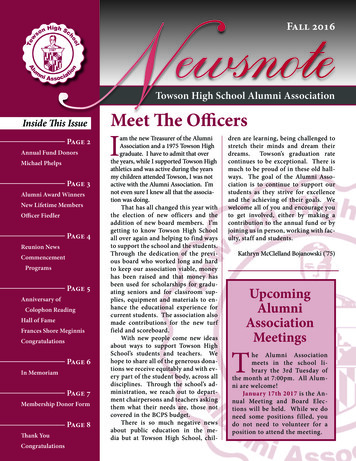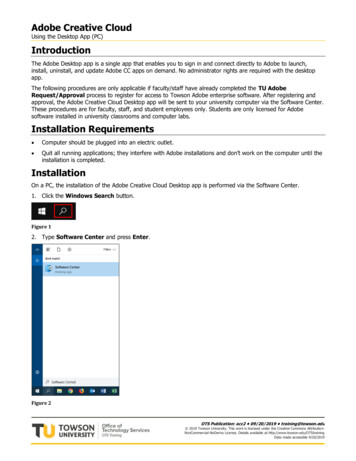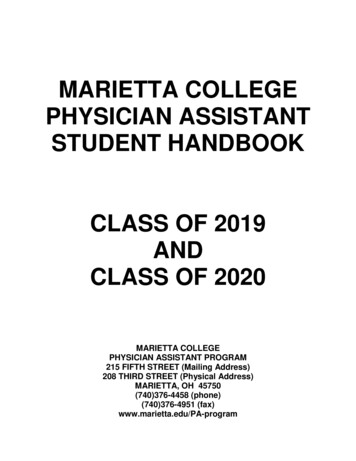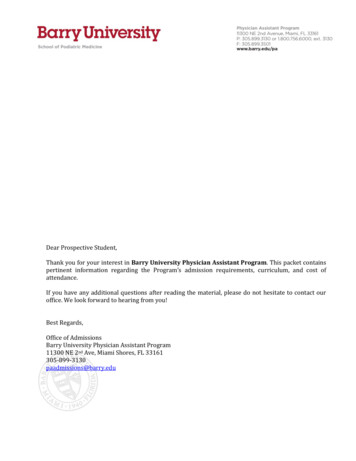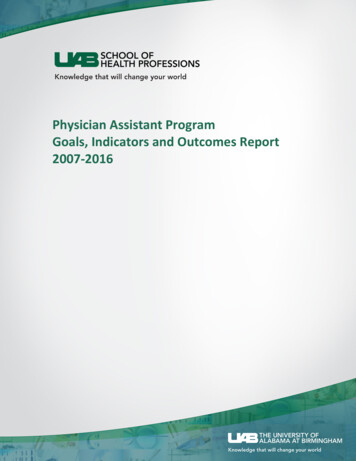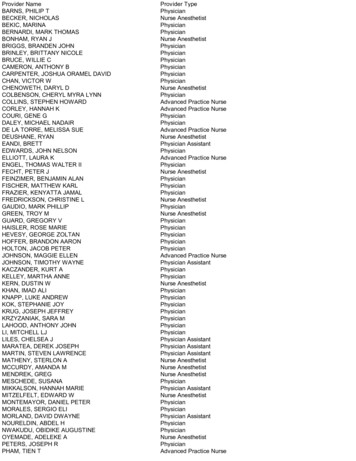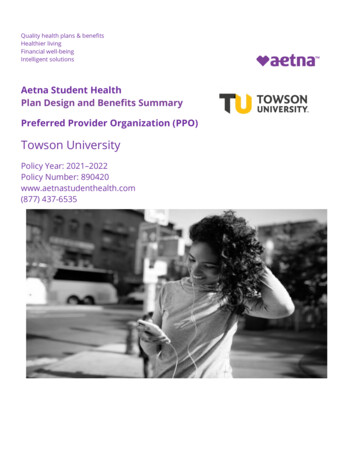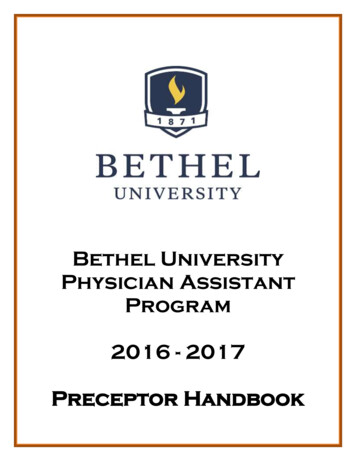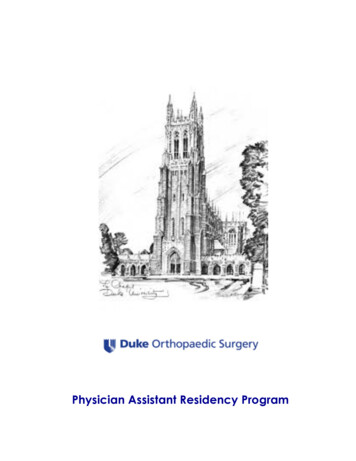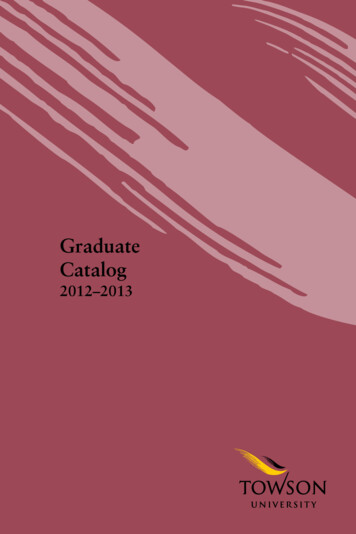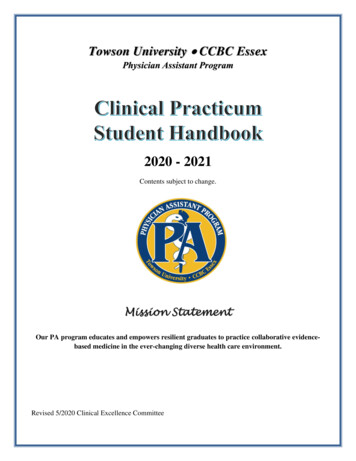
Transcription
Towson University CCBC EssexPhysician Assistant Program2020 - 2021Contents subject to change.Mission StatementOur PA program educates and empowers resilient graduates to practice collaborative evidencebased medicine in the ever-changing diverse health care environment.Revised 5/2020 Clinical Excellence Committee
Table of ContentsPageIntroduction.What to Expect From Clinical Rotations .Objectives .Description of Sites .Preceptors .Schedule .On-Site Faculty Evaluation.Student Responsibilities .Starting a New Rotation .Attitude .Representation .Dress Code .Attendance.Absences .Religious Holidays .Illness .Inclement Weather Policy .Professional Conduct .Confidentiality .Problems .Standards of Conduct .Probation .Academic and Clinical Dismissal .Remediation .Deceleration .Academic Dismissal .Professional Conduct (Disciplinary Dismissal) .Professional Conduct (Disciplinary) Dismissal Procedures .Rotation Requirements .Required Immunizations and Health Screenings .Site-Specific Paperwork .Personal Health Insurance Coverage/ Liability Insurance/Drug Screenings .Safety and Security .Injuries to Students on Clinical Site or Campus .Drug Screen, Alcohol Testing, and Background Check .Standard Precautionary Procedures .i12222333344445555677788991010111111121212131414
Table of Contents (Continued)PageGraduation Eligibility /Requirements .Chart Entry Signature .Patient Encounter Logs.Student Evaluation of the Clinical Rotation .Rotation/Course Grade Computation.Preceptor Evaluation .Mid-Rotation Evaluations .Post Rotation Examinations .Clinical Seminars .Grading Policy .Simulation Participant Assessments (OSCEs) .Clinical Practicum Objectives .Description .Reading and Study .Goals .Community Medicine .Emergency Medicine.Family Medicine .Psychiatry Requirements For Family Medicine Rotations .Internal Medicine .Pediatric Medicine .Surgery .Women’s Health.Elective Rotation and Final Preceptorship .Choosing a Rotation Site .General Elective .Final Preceptorship .Student Responsibilities when Choosing a Rotation Site .Contacting Other PA Programs for Sites .Final Preceptorship Objectives 63636373838AppendixFaculty and Staff Information Sheet .Holiday and Campus Activities .Program Clinical Evaluation.Mid-Rotation Evaluation .ii41424348
Table of Contents (Continued)PageAbsence Form .Incident Report.Letter of Intent.Physician Assistant Student Policy Agreement Clinical Year II .My Access Log-in .iii4950515253
Towson University CCBC EssexPhysician Assistant ProgramIntroductionWelcome to the Towson University CCBC EssexPhysician Assistant Program The clinical portion of the Physician Assistant Program begins in June of 2020 and extends throughMay of 2021. The Final Preceptorship begins May 31, 2021, continuing to July 23, 2021 for a total of8 weeks.The subject matter in PA education can be very sensitive and sometimes upsetting in nature. Students arereminded that the purpose of the educational sessions is to prepare students to provide physiciansupervised primary health care to all persons and in all environments without regard to the student's ownpersonal beliefs and biases. The expectation is to practice compliant patient centered care in diverseenvironments and areas of study.Due to the high standards of our program, our students are advised to remain prepared and focusedthroughout the entire curriculum. Because of the intensity of a graduate medical program and the natureof the profession, it is expected that students quickly become independent learners and learn to managetheir time and responsibilities while effectively completing the workload. It is also the expectation andresponsibility of each student to learn to problem solve, ask questions, and handle others with maturityand respect.The Core Rotations are listed below:1.2.3.4.5.6.7.8.Family PracticeInternal MedicinePediatricsWomen’s HealthEmergency MedicineSurgeryCommunity MedicineGeneral ElectiveAll core rotations are approximately 5-1/2 weeks in duration. The sites and dates are scheduled by theClinical Coordinator. The General Elective Rotation is based on availability by the program, though thefinal preceptorship may be chosen with the Clinical Coordinator’s help by students who are in goodstanding with the program.Students cannot switch or change clinical assignments without permission from the Clinical Coordinator.1
What to Expect From Clinical RotationsThe core of a Physician Assistant's education are the clinical rotations, where students become adept atinteracting with patients, didactic learning is applied, and new skills are practiced. After completing afew rotations, it will become apparent that there is no such thing as a typical rotation or a standardapproach. Schedules and plans change, and personality conflicts arise, therefore students must develop ahigh degree of flexibility and initiative to benefit fully from each rotation. It is to your benefit to learn asmuch about being a Physician Assistant in each rotation, including not only the medical knowledgeobtained but also the relationships, interactions, and time management that each preceptor demonstrates.Your role is part of an interprofessional team for patient care.ObjectivesThe PA program wants your clinical rotations to be both educational and interesting. You are expected tomaintain professional conduct and demeanor at all times. Each rotation specialty has a directed set ofobjectives, which are met through observation and participation at the clinical site and by attendingconferences and seminars with the preceptor. Students are responsible for independent reading and studyfor any topic area that cannot be covered on the clinical site. Students are referred to the PA Programrequired text list for independent reading and study, which is Access Medicine.Description of SitesThe clinical practicum focuses on the assessment and overall management of patients presenting to theclinical site. Students participate in all aspects of patient care including taking a thorough history,performing a complete and a focused physical exam, developing differential diagnoses and implementingtreatment plans in collaboration with the preceptor.Students will be exposed to both outpatient and inpatient settings. Every clinical site is different with eachpreceptor having their own schedule which students are expected to adhere to. Each has its own inherentassets and liabilities. Clinical sites within the same specialty vary. Some sites are highly structured witha heavy patient load and limited student/preceptor conference time, while others may have a low patientturnover rate with a lot of time for one-on-one instruction from the preceptor. Due to these variations, itwill be up to the student to glean the maximum from each rotation and to supplement what cannot be metclinically with readings based on the objectives for that rotation.PreceptorsOnly one preceptor listed on the evaluation form is responsible for monitoring the student’s performanceduring the rotation. The student may be placed with a single preceptor or part of a team. The lead preceptorwill consult with clinicians who had the most contact with the student to determine the final grade.The instruction style of the preceptor is, quite possibly, the most variable feature of the clinical rotation.Some preceptors have precious little time to spend with students one-on-one, and students are expected tobecome a part of the interpersonal team. Remember each preceptor comes with their own personality andexpectations. Flexibility and maturity are essential as well as adapting to your varying surroundings.2
ScheduleWhen the student was accepted into this program, it was emphasized that the demands of the programwould require the student’s full attention during its 26 months. This means personal, financial or anyother considerations, should have been as well organized as possible to allow the student to focus on thenecessities of the program. With the numerous aspects of scheduling clinical rotations, it is not possiblefor the student to choose which clinical site to attend. Preferences may be accommodated where possible.The final decision on student placement rests with the Clinical Coordinator.Students are strongly discouraged from seeking or continuing employment of any kind while enrolled inour program. However, if a PA student chooses to work during this time, it is their responsibility to ensuretheir employment does not interfere or conflict with any aspect of this program. This includes classattendance, clinical rotations (including distance of clinical sites) and/or academic progress. Programexpectations, assignments, exams, or any other student responsibility will not be changed or adjusted inany way to accommodate a student’s work environment.On-Site Faculty EvaluationSite visits serve several purposes. The preceptor can be kept abreast of program changes or schedulemodifications. The site and preceptor are evaluated against program standards. Student performance isevaluated. Site visits are also intended to keep the student in touch with the program over the course ofthe rotation. A minimum of 2 site visits (with a goal of up to 4) will be conducted per student throughoutthe clinical year.Assessment of the student’s performance during an on-site evaluation may include any or all thefollowing: review of chart entries, case presentation, and observation of interaction with staff and/orpatients.The student will be contacted by a faculty member to schedule a time for the On-Site Evaluation. Thestudent must confirm this time with the preceptor and ensure the preceptor will be available as well.Student ResponsibilitiesStarting a New RotationStudents are advised to contact their preceptor 3 weeks in advance of their upcoming rotation (please seePreceptor Contact List.) When starting a new rotation, it is best to take a day to observe the style of patientcare and learn the routine of that particular site and preceptor. Observe and ask questions. How are patientmedical records and other data recorded? Who co-signs notes and orders? Who is in charge? How arepatients followed in the system? Open communication with the preceptor will ensure a successfulexperience. Some rotations will have very specific requirements, while others may not be as structured orhave a predictable routine. The clinical year requires students to demonstrate their ability to observe,communicate, and hone their clinical skills as well as their professionalism.3
AttitudeThe amount of knowledge and expertise gained from each rotation is largely determined by the student’sattitude and behavior. If a student chooses a passive role, the learning experience will be minimal. If,however, a polite assertive stance is taken, the opportunity for learning is limitless. Therefore, it isessential that students take initiative on each rotation. Preceptors and staff will evaluate how eagerly youapproach tasks on rotation.There are always things to learn from different people in different professions. This is especially true inthe medical field, whether a student or a practicing professional. The student must make the preceptorand other colleagues aware of whom they are and that they are willing to learn from every situation.It is not only necessary, but also extremely beneficial to make every attempt to maintain an attitude ofmutual respect for all colleagues and accept all they have to offer. It is also imperative that you sharpenyour interpersonal skills to interact positively and competently with people of all social, cultural, religious,ethnic, and socioeconomic levels.Representation*It is imperative that students represent themselves accurately as Physician Assistant students while inthe clinical setting, regardless of former title—RN, MD, PhD, PharmD, etc.Physician Assistant students must be clearly identified as such. At minimum, students must wear anidentification badge at all times on site and introduce themselves to patients and hospital personnelas a Physician Assistant student. Students who work in a health care capacity must dress appropriatelyso as not to confuse or misrepresent their work role with their PA student status (i.e., the name badge andprogram emblem may not be worn unless the student is completing a program clinical assignment).Dress CodeDress Code for clinical rotations is business casual; tasteful and appropriate as deemed by the program(not too short or low cut, etc.) and/or the preceptor and site. Lab coats and clean, closed-toe shoes mustbe worn. Jewelry should not be oversized or excessive. NO scrubs unless instructed by the preceptorprior to reporting to the site. NO sandals, jeans, leggings, tight-fitting clothing, cargo shorts or tshirts.Clinical supervisors, preceptors and faculty reserve the right to address any student who is inappropriatelyor unprofessionally dressed. Program standards must be met in the classroom as well as in rotations. Ifthese expectations are not met, the student may be asked to leave their rotation and appropriate action willbe taken.AttendanceStudents are required to attend the site during the hours assigned by the preceptor and meet theprogram’s required minimum 40 hours per week. This may include evenings, nights, weekends, andsome holidays. Promptness, readiness, and enthusiasm are reflected in each student’s final evaluation.Students are expected to stay on site until all assigned work has been completed and the student isdismissed by the preceptor. Students will not create their own work schedule to present to their preceptors.4
Under no circumstances, are students allowed to sleep while at clinical rotations, unless student isscheduled to be on call overnight. This will be grounds for dismissal.AbsencesAn absence from the clinical site, without proper notification to the Preceptor (via phone) AND theClinical Coordinator (via email), or failure to complete a Student Absence or Leave Request Formbefore the end of the rotation will constitute an unexcused absence and result in failure of that rotation.The Clinical Coordinator and the preceptor must be notified immediately, by both phone and email,when absences for personal emergencies arise. The Clinical Coordinator will not notify the clinical siteof the absence for the student. Email or messages from another student will not suffice.A student Absence Form must be signed by the preceptor and returned to the Clinical Coordinator nolater than the first class day after the rotation ends (See Appendix). It is the student’s responsibility toarrange make-up time with the preceptor.If the student is aware that a future absence will be necessary, a student Absence Form must be completedand given to the Clinical Coordinator for approval at least 4 weeks in advance. (See Appendix)Religious HolidaysAbsences will be approved, provided that the preceptor and Clinical Coordinator are notified in advanceand clinical time is made up.IllnessAny student who is ill and is likely to be contagious should not report to a clinical rotation in order toprotect the preceptor, staff, and patients. As stated above, it is the student’s responsibility to notify thesite and the Clinical Coordinator, by both email and phone immediately. The student will need to obtaina doctor’s note to turn in to the Clinical Coordinator, and the missed time must be made up. A StudentAbsence Form (See Appendix) must be signed by the preceptor and returned to the Clinical Coordinatorno later than the first class day after the rotation ends.Inclement Weather PolicyStudents are not required to attend the clinical site on days when CCBC Essex and/or Towson Universityis closed due to inclement weather. However, it is strongly recommended that the student attend the siteif the commute can be made safely.If the student is unable to report to the site due to inclement weather, the preceptor AND the ClinicalCoordinator are to be notified immediately, by office phone and email, plus a Student Absence form mustbe returned to the Clinical Coordinator before the end of the rotation.5
Professional ConductExemplary professional conduct is expected of all Physician Assistant students at all times. With thisas a fundamental principle, the PA Program will not tolerate violations of ethical or moral values, such ascheating, plagiarism or unprofessional conduct. The PA student role requires that students be reliable andcompetent, exercise sound judgment and act with a high degree of personal integrity at all times. Whenproblems arise at the clinical site which cannot be addressed immediately by the preceptor, the ClinicalCoordinator is to be notified of the incident immediately via email or telephone.Further information:*American Academy of Physician Assistants (AAPA) Guidelines for Ethical conduct: https://www.aapa.org Unprofessional behavior includes, but is not limited to the following:Disobedience of or inappropriate challenge of orders or assignments from faculty,administrators, preceptors, or clinical supervising staffDisrespect for or insensitivity to a patient’s rights, privacy, and privileges (i.e., HIPPA violation)Failure to acknowledge or accept corrections or criticism and/or hostile or belligerent responsesor comments to the correctionFailure to follow the site’s rules and regulations and chain of commandFailure to communicate with clinical supervisors (MD, DO, PA, NP, etc.) to whom they havebeen assignedAssumption of sole responsibility of patient’s care without discussion with proper preceptors orother providers (i.e., pharmaceutical treatment, discharge, testing)Observation or performance of procedures not authorized by the clinical institution and/orpreceptorFailure to demonstrate a respectful attitude to peers, instructors, or other members of the healthcare teamUnreliable, undependable behavior at clinical siteLeaving the clinical site until all work has been completed and/or the preceptor approvesFailure to cooperate with preceptor, group, or team effortsFailure to deliver care without regard to race, ethnicity, age, sex, creed, religion, socioeconomicstatus, sexual orientation, national origin, and/or nature of medical/health care problem(s)Uncontrolled or disruptive behavior on site or campusReluctance to participate in standard medical procedures or failure to perform clinical proceduresin an acceptable mannerFailure to implement Universal Safety PrecautionsPhysical, verbal, or sexual harassment of anyone (patients, instructors, peers, or faculty)Performance of any duties (including class attendance) while under the influence of alcohol orillegal substances or while taking prescribed medications which can cause impairment ofbehavior, level of alertness or motor skillsAny violation of academic integrity (plagiarism, copying another student’s work, sharinganswers, using notes, phones or the internet during exams unless given specific permission) orviolation of the program’s clinical polices or the School of Health Professions’ Code of ConductAny other incident/behavior, not listed above, deemed inappropriate by the program6
Confidentiality Patients’ rights to confidentiality and privacy must be adhered to at all times.Posting anything on social media regarding classmates, faculty, preceptors, and academic orclinical sites is forbidden. This includes but not limited to Facebook, Twitter, Snapchat,Instagram, YouTube, or any other social media platform. Violation of this may result in dismissalfrom the program.Use of ANY electronic device is strictly prohibited during any clinical rotation unless givenspecific permission by the preceptor.Video recording, taping and photographs are prohibited in clinical site rotations.*All of the above are violations of the standards and polices of this program and this profession perHIPAA guidelines. The level of professionalism will be evaluated throughout the program andspecifically during the clinical year. Any violation is to be reported to the Clinical Coordinator andmay be cause for dismissal.ProblemsInvariably, problems arise during rotations. It is up to the student to clarify with the preceptor at theoutset of the rotation what the expectations are, eliminating unexpected surprises at the end of therotation. The mid-rotation evaluation is another tool used to measure progress. (See Appendix)Personality conflicts do occur and students may feel awkward if one arises, particularly with the personresponsible for their grade. Maturity, sensitivity, intellectual ability, and professionalism are necessary inany setting. Adaptability to mental, physical and emotional stress is essential to your clinical experienceand this profession. Always retain the highest level of integrity and compassion. Students will beexpected to accept direction and criticism and respond or modify their behavior to our standards. It iscrucial to identify difficulties as early as possible so as not to interfere with the student’s ability to learnor jeopardize a fair assessment of the student’s performance. The student should contact the ClinicalCoordinator, their Faculty Advisor, or their Faculty Session Advisor as soon as a problem developsin an attempt to lessen, if not solve the issue. All efforts will be made to reach a conclusion that is mutuallysatisfactory to both the student and the preceptor.Should a situation arise in which the student is requested to do something that he or she isuncomfortable doing, without direct supervision, the student must inform the preceptor and notperform the task until supervision is provid
Physician Assistant Program Introduction Welcome to the Towson University CCBC Essex Physician Assistant Program The clinical portion of the Physician Assistant Program begins in June of 2020 and extends through May of 2021. The Final Preceptorship begins May 31, 2021, continuing to July 23, 2021 for a total of 8 weeks.

